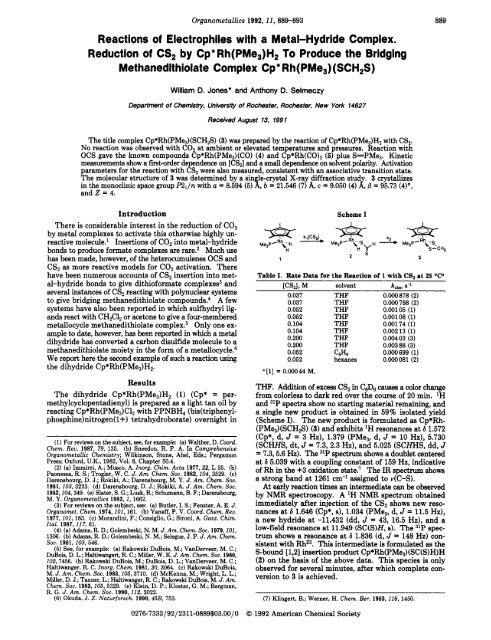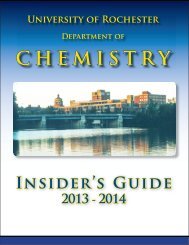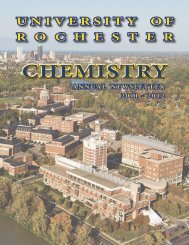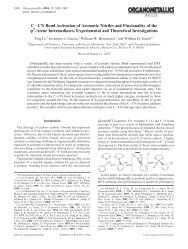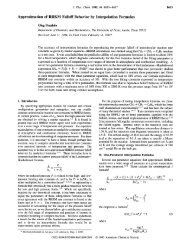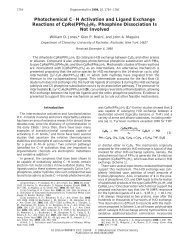Reactions of electrophiles with a metal-hydride complex. Reduction ...
Reactions of electrophiles with a metal-hydride complex. Reduction ...
Reactions of electrophiles with a metal-hydride complex. Reduction ...
Create successful ePaper yourself
Turn your PDF publications into a flip-book with our unique Google optimized e-Paper software.
Organo<strong>metal</strong>lics 1992,11, 889-893 889<br />
<strong>Reactions</strong> <strong>of</strong> Electrophiles <strong>with</strong> a Metal-Hydride Complex.<br />
<strong>Reduction</strong> <strong>of</strong> CSp by Cp*Rh(PMe,)H, To Produce the Bridging<br />
Methanedithiolate Complex Cp* Rh(PMe,) (SCH2S)<br />
William D. Jones" and Anthony D. Selmeczy<br />
Departtnent <strong>of</strong> Chemistry, UniversHy <strong>of</strong> Rochester, Rochester, New York 14627<br />
Received August 13, 199 1<br />
The title <strong>complex</strong> Cp*Rh(PMe3)(SCH2S) (3) was prepared by the reaction <strong>of</strong> Cp*Rh(PMe3)H2 <strong>with</strong> CSz.<br />
No reaction was observed <strong>with</strong> COz at ambient or elevated temperatures and pressures. Reaction <strong>with</strong><br />
OCS gave the known compounds Cp*Rh(PMe,)(CO) (4) and Cp*Rh(CO), (5) plus S=PMe3. Kinetic<br />
measurements show a fmborder dependence on ICs2] and a small dependence on solvent polarity. Activation<br />
parameters for the reaction <strong>with</strong> CSz were also measured, consistent <strong>with</strong> an associative transition state.<br />
The molecular structure <strong>of</strong> 3 was determined by a sin le-crystal X-ray diffraction stud . 3 crystallizes<br />
in the monoclinic space group ml/n <strong>with</strong> a = 8.594 (5) 1, b = 21.546 (7) A, c = 9.050 (4) l,fl=<br />
andZ=4.<br />
95.73 (4)O,<br />
Introduction<br />
There is considerable interest in the reduction <strong>of</strong> C02<br />
by <strong>metal</strong> <strong>complex</strong>es to activate this otherwise highly unreactive<br />
molecule.' Insertions <strong>of</strong> COz into <strong>metal</strong>-<strong>hydride</strong><br />
bonds to produce formate <strong>complex</strong>es are rare? Much use<br />
has been made, however, <strong>of</strong> the heterocumulenes OCS and<br />
CSz as more reactive models for COz activation. There<br />
have been numerous accounts <strong>of</strong> CS2 insertion into <strong>metal</strong>-<strong>hydride</strong><br />
bonds to give dithi<strong>of</strong>ormate <strong>complex</strong>es3 and<br />
several instances <strong>of</strong> CSz reacting <strong>with</strong> polynuclear systems<br />
to give bridging methanedithiolate compounds? A few<br />
systems have also been reported in which sulfhydryl ligands<br />
react <strong>with</strong> CHzCl2 or acetone to give a four-membered<br />
<strong>metal</strong>locycle methanedithiolate ~omplex.~ Only one example<br />
to date, however, has been reported in which a <strong>metal</strong><br />
di<strong>hydride</strong> has converted a carbon disulfide molecule to a<br />
methanedithiolate moiety in the form <strong>of</strong> a <strong>metal</strong>locycle.6<br />
We report here the second example <strong>of</strong> such a reaction using<br />
the di<strong>hydride</strong> Cp*Rh(PMe3)H2.<br />
Results<br />
The di<strong>hydride</strong> Cp*Rh(PMe3)H2 (1) (Cp* = permethylcyclopentadienyl)<br />
is prepared as a light tan oil by<br />
reacting Cp*Rh(PMe3)Clz <strong>with</strong> PPNBH4 (bis(tripheny1-<br />
phosphine)nitrogen(l+) tetrahydroborate) overnight in<br />
(1) For reviews on the subject, see, for example: (a) Walther, D. Coord.<br />
Chem. Reu. 1987, 79, 135. (b) Sneedon, R. P. A. In Comprehensive<br />
Organo<strong>metal</strong>lic Chemistry; Wilkinson, Stone, Abel, Eds.; Pergamon<br />
Press; Oxford, U.K., 1982, Vol. 8, Chapter 50.4.<br />
(2)(a) Immirzi, A.; Musco, A. Inorg. Chim. Acta 1977,22, L 35. (b)<br />
Paonessa, R. S.; Trogler, W. C. J. Am. Chem. SOC. 1982,104, 3529. (c)<br />
Darensbourg, D. J.; Rokiki, A.; Darensbourg, M. Y. J. Am. Chem. SOC.<br />
1981, 103, 3223. (d) Darensbourg, D. J.; Rokiki, A. J. Am. Chem. SOC.<br />
1982,104,349. (e) Slater, S. G.; Lusk, R.; Schumann, B. F.; Darensbourg,<br />
M. Y. Organo<strong>metal</strong>lics 1982, 1, 1662.<br />
(3) For reviews on the subject, see: (a) Butler, I. S.; Fenster, A. E. J.<br />
Organomet. Chem. 1974,101,161. (b) Yaneff, P. V. Coord. Chem. Rev.<br />
1977, 101, 183. (c) Morandini, F.; Consiglio, G.; Sironi, A. Cazz. Chim.<br />
Ital. 1987, I1 7, 61.<br />
(4)(a) Adams, R. D.; Golembeski, N. M. J. Am. Chem. SOC. 1979,101,<br />
1306. (b) Adams, R. D.; Golembeski, N. M.; Selegue, J. P. J. Am. Chem.<br />
SOC. 1981,103,546.<br />
(5) See, for example: (a) Rakowski DuBois, M.; VanDerveer, M. C.;<br />
DuBois, D. L.; Haltiwangert, R. C.; Miller, W. K. J. Am. Chem. SOC. 1980,<br />
102,7456. (b) Rakowski DuBois, M.; DuBois, D. L.; VanDerveer, M. C.;<br />
Haltiwanger, R. C. Inorg. Chem. 1981,20, 3064. (c) Rakowski DuBois,<br />
M. J. Am. Chem. SOC. 1983,105,3710. (d) McKenna, M.; Wright, L. L.;<br />
Miller, D. J.; Tanner, L.; Haltiwanger, R. C.; Rakowski DuBois, M. J. Am.<br />
Chem. SOC. 1983,105, 5329. (e) Klein, D. P.; Kloster, G. M.; Bergman,<br />
R. G. J. Am. Chem. SOC. 1990, 112, 2022.<br />
(6) Okuda, J. 2. Naturforsch. 1990, 458, 753.<br />
Scheme I<br />
Table I. Rate Data for the Reaction <strong>of</strong> 1 <strong>with</strong> CSz at 25 Oca<br />
ICS,1. M solvent L. s-'<br />
0.037 THF<br />
0.000878 (2)<br />
0.037 THF<br />
0.000788 (2)<br />
0.052 THF<br />
0.00105 (1)<br />
0.052 THF<br />
0.00108 (1)<br />
0.104 THF<br />
0.00174 (1)<br />
0.104 THF<br />
0.00213 (1)<br />
0.200 THF<br />
0.00403 (3)<br />
0.200 THF<br />
0.00388 (3)<br />
0.052 CsH,<br />
0.000699 (1)<br />
0.052 hexanes 0.000081 (2)<br />
[ 11 = 0.00044 M.<br />
THF. Addition <strong>of</strong> excess CS2 in C& cause8 a color change<br />
from colorless to dark red over the course <strong>of</strong> 20 min. 'H<br />
and 31P spectra show no starting material remaining, and<br />
a single new product is obtained in 59% isolated yield<br />
(Scheme I). The new product is formulated as Cp*Rh-<br />
(PMe3)(SCH2S)(3) and exhibits 'H resonances at 6 1.572<br />
(Cp*, d, J = 3 Hz), 1.379 (PMe3, d, J = 10 Hz), 5.730<br />
(SCHHS, dt, J = 7.3,2.3 Hz), and 5.025 (SCHHS, dd, J<br />
= 7.3,5.6 Hz). The 31P spectrum shows a doublet centered<br />
at 6 5.039 <strong>with</strong> a coupling constant <strong>of</strong> 159 Hz, indicative<br />
<strong>of</strong> Rh in the +3 oxidation state.' The IR spectrum shows<br />
a strong band at 1261 cm-' assigned to u(C-S).<br />
At early reaction times an intermediate can be observed<br />
by NMR spectroscopy. A 'H NMR spectrum obtained<br />
immediately after injection <strong>of</strong> the CS2 shows new resonances<br />
at 6 1.646 (Cp*, s), 1.034 (PMe3, d, J = 11.5 Hz),<br />
a new <strong>hydride</strong> at -11.432 (dd, J = 43, 16.5 Hz), and a<br />
low-field resonance at 11.949 (SC(S)H, 8). The 31P spectrum<br />
shows a resonance at 6 1.836 (d, J = 148 Hz) consistent<br />
<strong>with</strong> Rhm. This intermediate is formulated as the<br />
S-bound [ 1,2] insertion product Cp*Rh(PMe,)(SC(S)H)H<br />
(2) on the basis <strong>of</strong> the above data. This species is only<br />
observed for several minutes, after which complete conversion<br />
to 3 is achieved.<br />
(7) Klingert, B.; Werner, H. Chem. Ber. 1983, 116, 1450.<br />
0276-733319212311-0889$03.00/0<br />
0 1992 American Chemical Society
890 Organo<strong>metal</strong>lics, Vol. 11, No. 2, 1992<br />
0.005<br />
0.004<br />
0'<br />
0 0.05 0.1 0.15 0.2<br />
w21<br />
Figure 1. Plot <strong>of</strong> k h w [C&] for the reaction <strong>of</strong> Cp*Rh(PMe3)H2<br />
<strong>with</strong> CS2 at 25 "C.<br />
-a<br />
-10<br />
0.003 0.0031 0.0032 0.0033 0.0034<br />
1TT<br />
Figure 2. Eyring plot for the reaction <strong>of</strong> Cp*Rh(PMe3)H2 <strong>with</strong><br />
cs2.<br />
Table 11. Rate Data for the Reaction <strong>of</strong> 1 <strong>with</strong> CSz at<br />
Different Temperatures"<br />
temp, K k,, s-l temp, K k,, s-l<br />
298 0.0204 (1) 323 0.0737 (1)<br />
303 0.0273 (1) 333 0.0938 (1)<br />
313 0.0406 (1)<br />
[CS,] = 0.052 M; 113 = 0.00044 M.<br />
Table 111. Intramolecular Distances (A) and Angles (deg)<br />
for CD*Rh(PMe.)(SCH.S)<br />
distance<br />
angle<br />
Rh-S1 2.361 (1) S1-Rh-S2 73.58 (5)<br />
Rh-S2 2.376 (2) S1-Rh-P1 93.43 (5)<br />
Rh-P1 2.265 (1) S2-Rh-P1 87.43 (5)<br />
SIX1 1.832 (4) Rh-Sl-Cl 90.9 (1)<br />
S2-C1 1.821 (4) Rh-SP-Cl 90.7 (1)<br />
s1-Cl-SP 101.9 (2)<br />
The kinetics <strong>of</strong> this reaction were studied in detail.<br />
Rates were measured by monitoring the appearance <strong>of</strong><br />
product 3 by UV-visible spectroscopy at X = 320 nm for<br />
at least 5 half-lives. Pseudo-first-order kinetics were obtained<br />
<strong>with</strong> varying excess concentrations <strong>of</strong> CSz (Table<br />
I) using THF solvent. Data were fit assuming a singleexponential<br />
rise <strong>with</strong> constant <strong>of</strong>fset 4 (see Experimental<br />
Section). Plotting [CS,] vs kobs gives a straight line indicating<br />
first-order dependence on [CS,] (Figure 1). The<br />
slope <strong>of</strong> the line in Figure 1 gives kl = 0.0193 (8) M-' s-l.<br />
With the mechanistic scheme shown in Scheme I the<br />
rate law in eq 1 can be derived. Two limiting cases are<br />
possible: (i) kl[CSz] >> k2 and (ii) kz >> kl[CSz] which<br />
simplify to the expressions given in eqs 2 and 3, respectively.<br />
Jones and Selmeczy<br />
rate = [l]okze-kzt (2)<br />
rate = [l],kl[CS2]e-kl[cs~l~ (3)<br />
The first-order dependence on [CS,] indicates that regime<br />
ii is in fact the case under the conditions employed<br />
in the UV-visible kinetic experiments. The observation<br />
<strong>of</strong> intermediate 2 at early reaction times (
<strong>Reduction</strong> <strong>of</strong> CS2 by Cp*Rh(PMe3)H2 Organo<strong>metal</strong>lics, Vol. 11, No. 2, 1992 891<br />
0 n Scheme I11<br />
Figure 3. ORTEP drawing <strong>of</strong> Cp*Rh(PMe3)(SCH&3) <strong>with</strong> ellipsoids<br />
drawn at the 50% level.<br />
A<br />
B<br />
C<br />
Scheme I1<br />
by comparison <strong>with</strong> an authentic sample. Exclusive formation<br />
<strong>of</strong> 4 can be achieved by reacting 1 <strong>with</strong> a slight<br />
excess <strong>of</strong> OCS and freeze/pump/thaw degassing the sample<br />
thoroughly when no starting material remains. In this<br />
case little or no formation <strong>of</strong> 5 occurs and conversion to<br />
4, C5Me5H, and S=PMe3 is observed (as determined by<br />
'H and 31P NMR spectroscopy).<br />
Discussion<br />
Although single insertions <strong>of</strong> CS2 into <strong>metal</strong>-<strong>hydride</strong><br />
bonds are common, the reduction <strong>of</strong> CS2 to methanedithiolate<br />
has only been seen previously in the reaction <strong>of</strong><br />
Cp2MoH2 <strong>with</strong> CS2.7b No intermediates were detected in<br />
thiscase, however. In the present study, the initial reaction<br />
to form intermediate 2 is typical <strong>of</strong> insertions <strong>of</strong> unsaturated<br />
compounds into <strong>metal</strong> <strong>hydride</strong>s, but the subsequent<br />
step(s) are not. Several mechanisms can be envisioned for<br />
this transformation (Scheme 11, A-C). In path A, the<br />
dithi<strong>of</strong>ormate sulfur acts a8 a nucleophile, attacking the<br />
<strong>metal</strong> center and forming a carbocation. A coordinatively<br />
unsaturated <strong>metal</strong> center is required to allow attack <strong>of</strong> the<br />
sulfur atom at rhodium. This might be achieved by an q5<br />
- q3 ring slip or <strong>hydride</strong> to ring migration to give an<br />
(q4-C5Me5H)Rh1 species. A [1,3] <strong>hydride</strong> shift would then<br />
give the observed product. Alternatively, a [ 1,3] <strong>hydride</strong><br />
shift from rhodium to carbon might occur, followed by fast<br />
trapping <strong>of</strong> the Rh+ center by thiolate (path B). A third<br />
possibility is that <strong>of</strong> a [1,2] intramolecular insertion <strong>of</strong> the<br />
coordinated thioaldehyde into the Rh-H bond (path C),<br />
Multiple insertions <strong>of</strong> CS2 to give bis(dithi<strong>of</strong>0rmate) derivatives<br />
might be expected but are not observed.<br />
In an attempt to determine whether an ionic intermediate<br />
such as a charge-transfer <strong>complex</strong> is involved, the<br />
rate <strong>of</strong> the reaction was measured in THF, benzene, and<br />
hexanes (Table I). Comparison <strong>of</strong> these rates shows a<br />
slight decrease as the polarity <strong>of</strong> the solvent is diminished.<br />
Under the dilute pseudo-first-order conditions used in the<br />
kinetics experiments, the rate-determining step is the<br />
bimolecular reaction <strong>with</strong> CS2, not the subsequent rearrangement<br />
to give the methanedithiolate <strong>complex</strong>. Thus<br />
an initial charge-transfer <strong>complex</strong> appears unlikely, but<br />
the nature <strong>of</strong> the step subsequent to CS2 coordination and<br />
insertion cannot be probed by this kinetic data.<br />
Previous work by Jones et aL9 provided evidence for<br />
competing <strong>hydride</strong> migration and ring slip mechanistic<br />
pathways in the reaction <strong>of</strong> Cp*Rh(PMe3)H2 <strong>with</strong> D2 and<br />
<strong>with</strong> PMe3 (Scheme 111). Saturation kinetics were observed<br />
in the reaction <strong>with</strong> PMe3, giving a limiting value<br />
for kl < 5 X lo4 s-l. The reaction <strong>with</strong> D2, however, used<br />
concentrations <strong>of</strong> D2 too low to produce saturation behavior.<br />
A pseudo-first-order plot <strong>of</strong> [D2] vs hobs gave a<br />
value for k[k2//k[ = 3 X M-I s-I. It was proposed that<br />
the reaction <strong>with</strong> PMe, proceeds via an q5 - q3 ring slip<br />
pathway due to the absence <strong>of</strong> a kinetic isotope effect using<br />
an equimolar mixture <strong>of</strong> Cp*Rh(PMe3)H2/Cp*Rh-<br />
(PMe3)D2, while the reaction <strong>with</strong> D2 was believed to undergo<br />
a <strong>hydride</strong>-to-ring migration based on stepwise formation<br />
<strong>of</strong> Cp*Rh(PMe,)HD and Cp*Rh(PMe3)D2. Exchange<br />
<strong>of</strong> P(CD3)3 for P(CH3)3 in the starting material was<br />
slower than the reaction <strong>with</strong> PMe3 to give HRh(PMe3)4,<br />
thus ruling out phosphine loss as the initial step.<br />
Comparison <strong>of</strong> the rate <strong>of</strong> the CS2 reaction <strong>with</strong> these<br />
previous studies allows us to rule out the pathway that 1<br />
undergoes <strong>with</strong> PMe,, since the limiting rate kl is far too<br />
slow. Thus an q5 - q3 ring slip does not appear to be the<br />
initial step leading to coordination <strong>of</strong> free CS2. If we<br />
assume a small value for Kq.(k{/k-[) in the reaction <strong>with</strong><br />
H2 (K9 zz 0.05) then a limiting value for k2 I 0.06 M-' s-l<br />
is obtclmed, which is consistent <strong>with</strong> the kl measured for<br />
the reaction <strong>with</strong> CS2. We therefore cannot rule out a<br />
<strong>hydride</strong>-to-ring migration as a preequilibrium step. A<br />
concerted mechanism involving a four-membered transition<br />
state is also possible.<br />
Conclusion<br />
In conclusion, we have shown that di<strong>hydride</strong> 1 reacts<br />
<strong>with</strong> CS2 to produce the methanedithiolate <strong>complex</strong> 3 and<br />
<strong>with</strong> OCS to give the known <strong>complex</strong>es Cp*Rh(PMe3)(CO)<br />
(9) Jones, W. D.; Kuykendd, V. L.; Selmeczy, A. D. Organo<strong>metal</strong>lics<br />
1991, IO, 1577.
892 Organo<strong>metal</strong>lics, Vol. 11, No. 2, 1992<br />
(4) and Cp*Rh(CO), (5). The insertion product 2 is observed<br />
at early reaction times. The reaction <strong>with</strong> CS2 may<br />
proceed via an initial <strong>hydride</strong>-to-ring migration or may<br />
involve a concerted pathway through a four-membered<br />
transition state. No reaction <strong>with</strong> C02 was observed at<br />
ambient or elevated pressures and temperatures. This is<br />
only the second example reported to date for reduction <strong>of</strong><br />
CS2 to methanedithiolate and may be <strong>of</strong> interest concerning<br />
reduction processes involving sulfur-containing<br />
compounds. We are currently studying this and other<br />
related reactions as models for potential homogeneous<br />
HDS systems.<br />
Experimental Section<br />
All manipulations were performed under an inert atmosphere<br />
<strong>of</strong> nitrogen or on a high-vacuum line <strong>with</strong> the use <strong>of</strong> Schlenk<br />
techniques. Benzene, THF, and hexanes were distilled from<br />
purple solutions <strong>of</strong> benzophenone ketyL CS2 was purchased from<br />
Aldrich Chemical Co. and distilled before use. OCS and C02 were<br />
obtained from Matheson and were used as received. PPNBH4<br />
was prepared using the method <strong>of</strong> Bau.'O The <strong>complex</strong>es<br />
Cp*Rh(PMe&CO) and CP*R~(CO)~ were prepared as described<br />
by Werner." The <strong>complex</strong> Cp*Rh(PMe3)H2 was prepared as<br />
described elsewhere.12<br />
'H (400 MHz), 31P (162 MHz), and '3c (100 MHz) NMR spectra<br />
were recorded on a Bruker AMX-400 spectrometer. 'H NMR<br />
shifts were measured relative to residual 'H resonances in deuterated<br />
solvent: CsDs (6 7.15). 31P NMR spectra were reported<br />
in units <strong>of</strong> 6 (chemical shifta are referred to external 10% H3P04<br />
at 6 0.0 ppm). 13C NMR shifts were measured relative to the Ca8<br />
triplet (6 128). cas was purchased from MSD Isotopes Chemical<br />
Division and was vacuum-distilled from potassium-benzophenone<br />
prior to use.<br />
Reaction <strong>of</strong> Cp*Rh(PMe3)H2 <strong>with</strong> CSp Cp*Rh(PMe3)H2<br />
(0.026 mmol) was dissolved in 0.7 mL <strong>of</strong> C6D6, and the solution<br />
was placed in a NMR tube. The solution was subjected to three<br />
freeze/pump/thaw degas cycles. A 30-mL aliquot <strong>of</strong> CS2 (0.29<br />
mmol) was injected under an inert atmosphere. 'H and 31P NMR<br />
spectra recorded <strong>with</strong>in 5 min showed the presence <strong>of</strong> both<br />
Cp*Rh(PMed(SC(S)H)H (2) and Cp*Rh(PMe3)(SCH&) (3). 'H<br />
and 31P NMR spectra obtained after 20 min showed only 3.<br />
Spectroscopic data for 2: 'H NMR (cas) 6 -11.432 (dd, J = 43,<br />
16.5 Hz, 1 H), 1.035 (d, J = 11.5 Hz, 9 H), 1.646 (8, 15 H), 11.949<br />
(s, 1 H); 31P(1HJ NMR (C6Ds) 6 1.836 (d, J = 148 Hz). Spectroscopic<br />
data for 3 'H NMR (C&) 6 1.379 (d, J = 10 HZ, 9 H),<br />
1.572 (d, J = 3 Hz, 15 H), 5.025 (dd, J = 7.3,5.6 Hz, 1 H), 5.730<br />
(dt, J = 7.3, 2.3 Hz, 1 H); 13C(lH) NMR (C&) 6 98.522, 53.972,<br />
15.262 (d, J 30 Hz), 9.402; 31P('HJ NMR (C&) 6 5.038 (d, J<br />
= 159 Hz); IR (KBr) 2962,2904,1261,1095,1022,802 cm-'. Anal.<br />
Calcd for RhPS2C14H2e: C, 42.86; H, 6.68; P, 7.89. Found C,<br />
42.24; H, 7.15; P, 7.12.<br />
Kinetic Studies <strong>of</strong> Cp*Rh(PMe3)H2 + CS2. All kinetic<br />
experiments were carried out using a 0.01 M standard solution<br />
<strong>of</strong> Cp*Rh(PMe3)H2 in THF. In a typical experiment, 20 pL <strong>of</strong><br />
the standard solution was injected into a 0.1-mm quartz cell and<br />
diluted to 0.45 mL <strong>with</strong> THF ([l] = 4.4 X lo-' M). A 1.0-5.4-pL<br />
aliquot <strong>of</strong> CS2 was then injected into the cell under inert atmosphere<br />
and the contents shaken thoroughly. The sample was then<br />
immediately placed in a temperature-regulated UV-visible cell<br />
at 25 "C, and absorbances were measured every 10 s at h = 320<br />
nm for at least 5 half-lives. Data were fit to the equation At =<br />
(Ar& - Ao)(l - e-kr) + A. by varying k. For 1, A, = 292 nm;<br />
for 3, A, = 320 nm.<br />
Reaction <strong>of</strong> Cp*Rh(PMe3)H2 <strong>with</strong> OCS (2 equiv).<br />
Cp*Rh(PMe3)H2 (0.052 mmol) was dissolved in C6D6, and the<br />
solution was placed in a NMR tube. The solution was subjected<br />
to three freeze/pump/thaw degas cycles. OCS (36 Torr) was<br />
introduced into a "L ampule (0.10 mol) and condensed into<br />
(IO) Kirtley, S. W.; Andrews, M. A,; Bau, R.; Grynkewich, G. W.;<br />
Marks, T. J.; Tipton, D. L.; Whittlesey, B. L. J. Am. Chem. SOC. 1977,<br />
99, 7154.<br />
(11) Werner, H.; Klingert, B. J. Organomet. Chem. 1981, 218, 395.<br />
(12) Jones, W. D.; Kuykendall, V. L. Inorg. Chem. 1991, 30, 2615.<br />
Jones and Selmeczy<br />
Table IV. Summary <strong>of</strong> Crystallographic Data for<br />
Cp*Rh(PMeJ)(SCH2S)<br />
Crystal Parameters<br />
chemical formula<br />
RhP1S2C14H26<br />
fw 392.359<br />
cryst syst<br />
monoclinic<br />
space group (No.) P2,/n (14)<br />
z 4<br />
a, A 8.594 (5)<br />
b, 8, 21.546 (7)<br />
c, A 9.050 (4)<br />
8, deg 95.73 (4)<br />
vol, A3 1667.32<br />
Pcdc, g cm" 1.563<br />
cryst dimens, mm<br />
0.15 X 0.19 X 0.75<br />
temp, "C -75<br />
Measurement <strong>of</strong> Intensity Data<br />
diffractometer<br />
Enraf-Nonius CAD4<br />
h(Mo Ka radiation, graphite 0.71073<br />
monochromatized), A<br />
scan type 28/w<br />
take<strong>of</strong>f angle, deg 2.6<br />
total bkgd time<br />
(scan time)/2<br />
scan rate, deg min-' 2-16.5<br />
scan range, deg<br />
0.7 + 0.35 tan 8<br />
28 range, deg 4-40<br />
data collcd<br />
+h,+k,*l<br />
no. <strong>of</strong> data collcd 3234<br />
no. <strong>of</strong> unique data F2 > 3u(F2) 2730<br />
no. <strong>of</strong> params varied 163<br />
M, cm-* 13.275<br />
systematic absences<br />
OkO, k odd<br />
hOZ, h + 1 odd<br />
abs corr<br />
differential<br />
range <strong>of</strong> trans factors<br />
0.957-1.0_37<br />
equiv data<br />
OkZ = Okl<br />
agreement between equiv data (F,) 0.019<br />
RW,) 0.0264<br />
RJFA 0.0383<br />
goodness <strong>of</strong> fit 1.818<br />
the tube. The reaction was monitored by 'H and 31P NMR<br />
spectroscopy for 5 days. Spectroscopic data for 4 'H NMR (C&J<br />
6 1.051 (d, J = 9.2 Hz, 9 H), 1.970 (d, J = 1.7 Hz, 15 H); 31P(1H)<br />
NMR (CsD6) 6 -5.160 (d, J = 190 Hz). 13C('H) NMR (C& 6<br />
199.47 (dd, J = 88.26 Hz), 97.65, 20.28 (d, J = 29 Hz), 11.47; IR<br />
(KBr) 2961, 2918, 1927, 1262, 1098, 1024, 802 cm-'.<br />
Reaction <strong>of</strong> Cp*Rh(PMe3)H2 <strong>with</strong> OCS (60 equiv).<br />
Cp*Rh(PMe3)H2 (0.052 mmol) was dissolved in CsDe, and the<br />
solution was placed in a NMR tube. The solution was subjected<br />
to three freeze/pump/thaw degas cycles. OCS (100 Torr) was<br />
introduced into a high-vacuum line (approximate volume 600 mL;<br />
3.2 mmol) and condensed into the tube. The reaction was<br />
monitored by 'H and 31P NMR spectroscopy for 24 h. The<br />
solution became dark red. After 24 h, in addition to 5, free Cp*H<br />
was detected by 'H NMR spectroscopy (c&) at 6 2.405 (9, 1 H,<br />
J = 7.6 Hz), 1.786 (8, 6 H), 1.729 (s, 6 H), and 0.978 (d, 3 H, J<br />
= 7.6 Hz), and SPMe3 at 6 1.033 (d, J = 13 Hz). Spectroscopic<br />
data for 5: 'H NMR (cas) 1.735 (8); IR (KBr) 2964, 2921,2017,<br />
1959, 1948, 1261, 1092, 1022,951,804 cm-'.<br />
Reaction <strong>of</strong> Cp*Rh(PMe3)H2 <strong>with</strong> C02 (1 atm). Cp*Rh-<br />
(PMe3)H2 (0.052 mmol) was dissolved in c&, and the solution<br />
was placed in a NMR tube. The solution was subjected to three<br />
freeze/pump/thaw degas cycles. C02 (700 Torr) was introduced<br />
into the sample on a high-vacuum line. No reaction was observed<br />
at 23 "C. The sample was heated at 80 "C for 24 h, during which<br />
time considerable darkening occurred due to some decomposition.<br />
No reaction was observed by 'H or NMR spectroscopy.<br />
Reaction <strong>of</strong> Cp*Rh(PMe3)H2 <strong>with</strong> C02 (7 atm). Cp*Rh-<br />
(PMe3)H2(0.026 "01) was dissolved in THF, and the solution<br />
was placed in a glass-lined bomb apparatus. C02 (100 psi) was<br />
introduced into the bomb and the mixture heated at 60 "C for<br />
24 h. The residue in the bomb was dissolved in C6D6. No<br />
identifiable products were detected by 'H or 31P NMR spectroscopy.<br />
Preparation <strong>of</strong> S=PMe3. PMe3 (250 pL, 2.4 "01) and sulfur<br />
(75 mg, 2.4 mol) were heated to 90 "C for 1 h. A white crystalline
Organo<strong>metal</strong>lics 1992,11, 893-900 893<br />
solid was formed. Yield 223 mg <strong>of</strong> S=PMe, (2.06 mmol, 86%).<br />
‘H NMR (C&): 1.0482 (d, J = 13 Hz). 31P(1HJ NMR (C&):<br />
27.81 (9).<br />
X-ray Structure <strong>of</strong> Cp*Rh(PMes)(SCHzS). A single crystal<br />
<strong>of</strong> the <strong>complex</strong> (crystal dimensions 0.15 X 0.18 X 0.75 mm) was<br />
mounted, and cell constants were obtained from 25 centered<br />
reflections <strong>with</strong> values <strong>of</strong> x between 0 and 70°. A quadrant <strong>of</strong><br />
data was collected in accord <strong>with</strong> the parameters given in Table<br />
IV. The Molecular Structure Corporation TEXSAN analysis<br />
s<strong>of</strong>tware package was used for data reduction and s01ution.l~ A<br />
scheme. The qGantity minimized was x;(IFoI - lFc1)2. Source <strong>of</strong> scac<br />
tering factors fo, f’, f”: Cromer, D. T.; Waber, J. T. International Tables<br />
for X-Ray Crystallography; Kynoch Press: Birmingham, England, 1974;<br />
Vol. IV, Tables 2.2B and 2.3.1.<br />
standard Patterson map solution <strong>of</strong> the structure to locate the<br />
rhodium, followed by expansion <strong>of</strong> the structure <strong>with</strong> the program<br />


